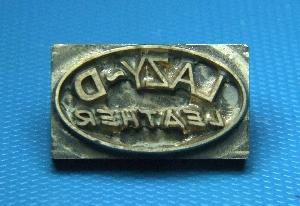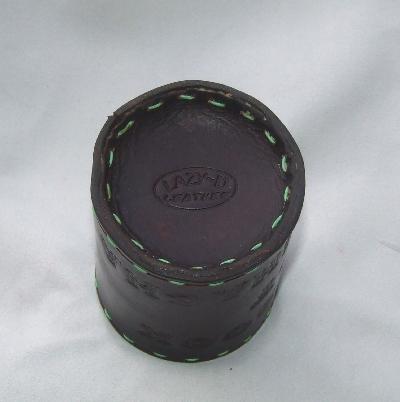-
Posts
5,886 -
Joined
Content Type
Profiles
Forums
Events
Blogs
Gallery
Everything posted by fredk
-

Frozen Neatsfoot Oil??
fredk replied to Hardrada's topic in Dyes, Antiques, Stains, Glues, Waxes, Finishes and Conditioners.
yes it can. It usually says on the container 'do not allow to freeze' or 'do not store below x* temperature' for this reason Defreeze slowly, mixing the oils together constantly and it may be saved -
A Happy, Healthy, Peace-filled, Prosperous New Year to all leather workers May you cut your patterns right-sided, and not your fingers. May all your leather hides be perfect and your own hide be thick enough to ignore jibes and complaints May your leather dyes soak in evenly and buff up well and die may not come to those you love May your wanted edges be as slick as an ice rink but may you never be on the edge of want May your sewing stitches be as straight as the road to Heaven and the road to the Devil be as crooked as one of my 'mystery braid' straps F
-
well, there ya go. who would have thunk you'd find one in amongst leather working tools. In the UK the survey people use a rather plain slightly raised head brass pin/nail thingy
-
I only use a beeswax/carnauba wax/nfo mix for edges. It seals the edges well, slicks the edges nicely, easy to apply and easy to buff smooth. I make sure the edge is well dyed before slicking but the odd time I've not and dye has been able to get to the leather despite the wax. What you are looking for sounds like a 'tucktite' lock. Usually used on lightweight brief cases and such. Example below. There are variations of this http://www.leprevo.co.uk/photos/tucktite.html You can use it without the main lock section and just a bar A makers mark is always good to have and use. You don't say where you are located - please add this to your 'profile' so we can help you better. This is an international forum with members all over the world I get brass stamps made by guys in China. I currently use two different makers. Both are quick and cheap. I alternate as they take long holidays! My makers stamp, in brass, cost about £15. It 3cm across by 2 cm high. The maker took about 10 days total, from me sending the image until it dropped thru my letterbox. Post is a bit slower now, latest stamp took 18 days total I believe we have a dedicated thread about makers stamps, where to get them made, prices et cetera You can pay a lot or not for a stamp. Search out carefully.
-

Made a Newb Mistake
fredk replied to garypl's topic in Gun Holsters, Rifle Slings and Knife Sheathes
On some patterns I write a bit more; like, 'this side up, other side to flesh' If the item is 'handed' then I add '. . . for Right Hand, turn over for Left Hand' -
1. do not wet form around the watch. carve up a wood or mdf block to mould around and attach that to a bigger piece of wood. 2. use the stretchiest belly leather you can get 3. use a frame over and around the block former covered in wet leather and clamp it down real tight
-
Depends on what you're gonna be making. As I often make board games and the boards are between 30 and 42 cm square anything less than 45 to 50 cm is no good. But when I'm making valet trays and such 30 cm x 40 cm is good enough
-

Important Customs news for UK/Eu leatherworkers
fredk replied to fredk's topic in Marketing and Advertising
you think thats confusing. . . . many courier companies are refusing to take packages from GB destined for N.I. ! All within the UK but they think that the VAT & customs will be different after 1/1/21 -
I'm not sure #2 is for a shoe sole, I think its a book binders edger
-
I use various strengths of reading glasses for close-up work. I have strengths from 1 to 3.5. One pair costs £1 at the.. . . err, £-shop. I have several pairs of glasses, which I can leave in my thread sewing kit, lacing kit, a few kicking around the general work bench and some on my plastic modelling bench
-
quick look #1 is a counter sink maker, for woodworking, turn it to cut a countersink hole for screw head #9 is an upholstery tack lifter, push the v under the tack head to lever the tack off #6 looks like a tapered hole-reamer, for enlarging holes slightly #4 looks like a parallel hole reamer, for cleaning holes already made #8 looks like a nail setter - for the final whacking of a broad-head nail to set it flush with woodwork
-
My sincere apologies. I jumped in on the tail end of this thread and never really read the start This is indeed clever and well thought out. T'is a shame I do not have access to the sort of tools needed to make somat like it.
-

Custom. 'N" jokes. 'n' stuff.
fredk replied to JLSleather's topic in Gun Holsters, Rifle Slings and Knife Sheathes
A couple of years ago I overheard my son doing this routine with a customer. My No.1 dismantles BMW cars and sells 2nd hand parts. A guy came in looking an engine and drive train. I'll not repeat it all but it went very much like the story above. -
I just ask my supplier, Le Prevo, for any hides with scars or marks. They tend to sell such as lower quality suitable for 'historical re-enactment' as opposed to first quality for 'top-class' bags
-
me - roofers framing square for large pieces, woodworkers framing square for smaller. Rotary knife for thin leather, eg anything under 1.4mm or approx 3.5 oz
-
There might be major hardware store in your vicinity. Most of these will do mail order now with us all being locked up. Basically most of these hardware stores charge cents for D or O rings and you can buy 1 or a dozen The place I bought from (closed down now but I have another source) charged anything between 20p and 50p per ring, depending on size. A 'leather work' lighter weight version was between £1.50 to £3 for same size
-
For strong duty steel D and O rings I bought them from a farmers & builders supply merchant. I found the ones meant for 'leatherwork' were just not up to the job, they could be bent too easily. The ones I bought were meant for chain coupling and were very much stronger and very much cheaper. I also got the occasional roller buckle from the same place
-
Tandy allows free distribution of their patterns which they have offered free and for users to make unlimited items using those patterns You (the general you) must not pass off a Tandy pattern as your own. This includes patterns and tip sheets et al drawn up by the Tandy representatives for Tandy
-
Those look very nice indeed
-

Explain this hammer thong
fredk replied to MarlinDave's topic in Gun Holsters, Rifle Slings and Knife Sheathes
May I add; that doesn't look like an ordinary washer. It looks like a coin or token. Perhaps something the holster owner picked up, maybe considered it his 'lucky' coin and wanted it on the strap My grandfather had a Chinese coin, which was round with a square hole in the centre, on his watch chain. He picked it up in the Philippines during the US-Spanish War there. He said it was a 'lucky coin' to him -
I'm too tight a-wallet to throw these sorts of things away. If it was me I'd set up to drill out a hole on the back, tap it for a 3mm or 4mm flanged head screw and turn them into screw-attachable Same Browne studs
-
I've not had to do many straps recently, but, rather dip in a tray I got a length of plastic piping, about 4.5 feet long by 2 inches i/d. I sealed up one end. I mount that vertically with pipe clips on the side of a small bench. I attach a piece of wire to one end of the strap for hanging up. Also using that wire as a grip I dip the strap into the dye in the piping tube. I let the strap soak for a bit then I draw it out, allowing it to draw, carefully, over the edge of the tube which takes off some liquid dye on the strap surface. Then I hang it up to dry. If the strap is more than about 4 to 4.3 feet, I just dip dye one end, up to about 2/3 length, draw it it and reverse it and dye the remaining part plus a generous overlap. As the leather is bring dipped dyed and the dye is allowed to soak in I find there is no noticeable difference on the ends of a long strap. But the tube doesn't hold much dye, maybe 1 litre, and the leather soaks it up pretty quickly so a good stock of dye, thinned or not, needs to be ready to make sure all the straps are the same colour
-
you'll never quieten the noise of the hammering still using a mallet. I changed to using a press, a Tandy one. I can do virtually all my stamp impressions with it, any time night or day. In fact, its 02.43 here and I did some stamp impressions about an hour ago. My neighbours don't hear the press,
-
The copper & washer rivets you don't want to or cannot use




